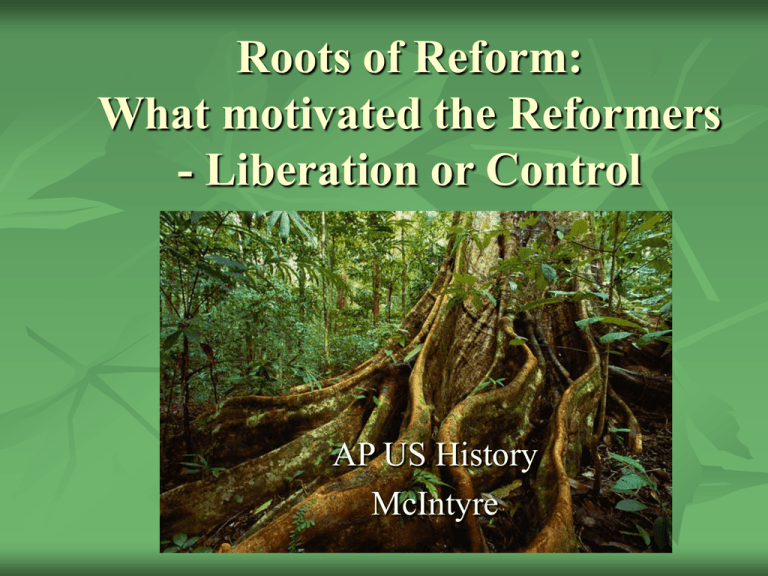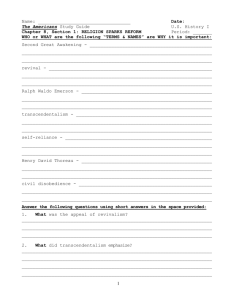Reform Movements of the 1840s
advertisement

Roots of Reform: What motivated the Reformers - Liberation or Control AP US History McIntyre Brief Intro to Reform Movements What kinds were there? Temperance: Bringing back the rum. Inflictions caused by overindulgence of alcohol, cholera, murder, epilepsy, etc. Woodcut, ca.1820. Temperance Abolition Women’s Rights Clothing and diet reform Utopianism Educational Reform Prison Reform/reforms for the mentally ill Brief Intro to Reform Movements When do we see these reform movements? Front Page of Abolitionist Paper The front page of the April 23, 1831 issue of The Liberator. Published by William Lloyd Garrison, it was a paper that called for the abolition of slavery as an institution. It's slogan was "Our Country is the World--Our Countrymen are Mankind." 1830s-50s Brief Intro to Reform Movements Why do we see these reform movements at this time? Much trickier question This is a question that has intrigued historians recently How do we find out why they wanted to reform society? What Historians would do is look for: 1. Patterns between groups 2. Intellectual roots of the movements 3. Historical events that came beforehand 4. Reformers backgrounds Why reform? Why the 1830s? 1. Patterns: What do they have in common? A. Most involved in multiple causes (not just one) Ex. Horace Mann B. Most were of middle class or upper class backgrounds Winship, A.E. Great American Educators. New York: Werner School Book Company, 1900.. http://www.lib.utexas.edu/exhibits/portraits/inde x.html Why reform? Why the 1830s? 2. Intellectual roots: A. Enlightenment general belief in science and reason Declaration of independence - “all men created equal” People Reaching for the Stars Image: © Images.com/Corbis Why reform? Why the 1830s? 2. Intellectual roots: B. Puritan Tradition Emphasis on individual Necessity of perfecting society Puritans Going to Church Original caption: "Thanks be to God for winter time! That bore the Mayflower up, To pour amid New England snows the treasures of its cup, To fold them in its icy arms, those sturdy Pilgrim sires, And weld an iron brotherhood around their Christmas fires." - B.F. Taylor. Why reform? Why the 1830s? 3. Historical Events: A. Second Great Awakening Sense of responsibility to God and fellow men Charles G. Finney emphasized salvation through social change Ex. Abolitionism very successful in “burned over district” Camp-meeting / A. Rider pinxit ; drawn on stone by H. Bridport. Library of Congress digital ID: (color film copy transparency) cph 3g04554 http://hdl.loc.gov/loc.pnp/cph.3g04554 (b&w film copy neg.) cph 3a52048 http://hdl.loc.gov/loc.pnp/cph.3a52048 Why reform? Why the 1830s? 3. Historical Events: B. British Anti-slavery Movement Banned slavery in 1833 (immediate emancipation) Influential Britons like Wilberforce had American financial backers (ex. Tappens) Illustration of Children Presenting Petition To End Slavery Original caption: Children presenting petition for abolition of slave trade. From English children's book ca. 1830. Image: © Bettmann/CORBIS Date Photographed: 1830 Location Information: England Why reform? Why the 1830s? 3. Historical Events: C. Industrial Revolution Changes in expectations for workers Transportation revolution Rapid urbanization Breakdown of traditional ways of caring for dependents Exterior of Boott Cotton Mill Original caption: Exterior view of the Boott Cotton Mills at Lowell, Massachusetts. Undated engraving. Image: © Bettmann/CORBIS Why reform? Why the 1830s? 4. Reformers themselves: 1. We’ll come back to that! Thinking Question: Which of these “roots” of reform do you think would be most influential so far? Why? Liberation Argument: Liberation: What? Reformers did it for humanitarian reasons Why? Believed man and his institutions were perfectible Optimism combined with religious evangelicalism Woman sitting on swing Image: © Images.com/Corbis Liberation Argument: Historiography: Until 1960s, most historians focused on whether the reformers did “good” or “bad” (not why they wanted to reform society) Liberation ideas popular with “good” school of thought “Social Control” Argument: What? Reform was a tool used by elites to control those of lower status Image: © Jud Guitteau/Illustration Works/Corbis Photographer: Jud Guitteau “Social Control” Argument: Historiography. Grew popular in 1960s & 1970s Interested in relationship between problems of industrial revolution & reform More recently - women’s involvement as a springboard to further activism and control Thinking Slide: Why did the “Social Control” thesis become so popular in the 60s and 70s and does that weaken the thesis? “Social Control” Argument: The Problem: Society changing very rapidly, breakdown of values The Solution Reforms emphasize dependability, willingness to work, acceptance of one’s place in the social order Funneling People into Universe Image: © Images.com/Corbis Creator Name: Janusz Kapusta “Social Control” Argument: Temperance: Control drinking of urban immigrant poor Education Schools as a place to teach values to lower classes (morals and work) ABC by Jennifer Kennard Image: © Jennifer Kennard/CORBIS “Social Control” Argument: Institutional reforms: Defined “deviant” behaviors and built structures to police them (mental institutions, prisons, poorhouses) 42-18121956| RM| © Jordi Elias/Illustration Works/Corbis Bad Times Image: © Jordi Elias/Illustration Works/Corbis “Social Control” Argument: Abolition: Theory seems to work less effectively until…. David Donald– abolitionism was how past elites tried recapture their moral/political authority Henry Ward Beecher Clergyman Henry Ward Beecher (1813-1887), nationally known as a speaker against slavery and supporter of women's voting rights. Image: © CORBIS Date Photographed: “Social Control” Argument: 4. Reformers themselves A. Abolitionists - Demographics: Donald looked at 250 abolitionist leaders for patterns B. Results median age 29 85% from New England 30% from Mass. alone nd generation immigrants or born abroad Only 4 were 2 “Social Control” Argument: Results (Cont’d) High degree of education Rural Ancestry Puritan Federalists Parent were preachers, doctors, teacher, farmers Very few were bankers and none were factory owners “Social Control” Argument: Results (Cont’d) C. His Theory – Reformers were an elite without a purpose Had no problems with capitalism (just wrong people taking control) William Lloyd Garrison Abolitionist William Lloyd Garrison (1805-1879) was the foremost voice against slavery in the U.S. from 1830 on. His paper, The Liberator, demanded the complete and immediate abolition of all slavery. He also headed the American Anti-Slavery Society, which was responsible for mobilizing thousands against the institution. Image: © CORBIS Date Photographed: ca. 1870 Thinking question: Donald has some convincing arguments to make about white male leaders, but a significant minority of abolitionists were women and African Americans. How do they fit into the picture? “Social Control” Argument: D. Related Argument; David Brion Davis – The Problem of Slavery in the Age of revolution: 17701823 Antislavery popular as a contrast between “free labor” and the evils of slavery It legitimizes the exploitation of workers in the north (better than the south) Strike by Boris Mihajlovic Kustodiev Image: © The Gallery Collection/Corbis Creator Name: Boris Mihajlovic Kustodiev Date Created: 1900-1927 Thinking Slide; Whose argument or combination of arguments is a more compelling answer to the question Why reform, why the 1830s: 1. Intellectual 2. Historical 3. Liberation 4. “Social Control”




